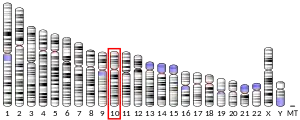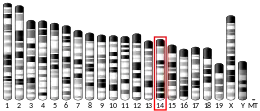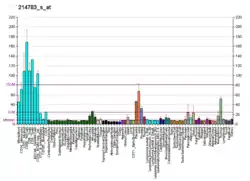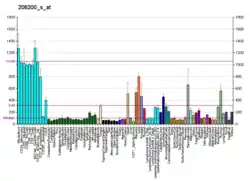Annexin A11
Annexin A11 is a protein that in humans is encoded by the ANXA11 gene.[5][6][7]
Function
This gene encodes a member of the annexin family, a group of calcium-dependent phospholipid-binding proteins. Annexins have unique N-terminal domains and conserved C-terminal domains, which contain the calcium-dependent phospholipid-binding sites. The encoded protein is a 56-kD antigen recognized by sera from patients with various autoimmune diseases. Transcript variants encoding the same isoform have been identified.[7]
Clinical significance
It is shown that over-expression of the ANXA11 is involved in apoptotic alterations in schizophrenia and contribute to pathomechanisms of this disorder.[10]
References
- GRCh38: Ensembl release 89: ENSG00000122359 - Ensembl, May 2017
- GRCm38: Ensembl release 89: ENSMUSG00000021866 - Ensembl, May 2017
- "Human PubMed Reference:". National Center for Biotechnology Information, U.S. National Library of Medicine.
- "Mouse PubMed Reference:". National Center for Biotechnology Information, U.S. National Library of Medicine.
- Misaki Y, Pruijn GJ, van der Kemp AW, van Venrooij WJ (Feb 1994). "The 56K autoantigen is identical to human annexin XI". The Journal of Biological Chemistry. 269 (6): 4240–6. PMID 7508441.
- Morgan RO, Bell DW, Testa JR, Fernandez MP (Feb 1998). "Genomic locations of ANX11 and ANX13 and the evolutionary genetics of human annexins". Genomics. 48 (1): 100–10. doi:10.1006/geno.1997.5148. PMID 9503022.
- "Entrez Gene: ANXA11 annexin A11".
- Satoh H, Shibata H, Nakano Y, Kitaura Y, Maki M (Mar 2002). "ALG-2 interacts with the amino-terminal domain of annexin XI in a Ca(2+)-dependent manner". Biochemical and Biophysical Research Communications. 291 (5): 1166–72. doi:10.1006/bbrc.2002.6600. PMID 11883939.
- Satoh H, Nakano Y, Shibata H, Maki M (Nov 2002). "The penta-EF-hand domain of ALG-2 interacts with amino-terminal domains of both annexin VII and annexin XI in a Ca2+-dependent manner". Biochimica et Biophysica Acta (BBA) - Proteins and Proteomics. 1600 (1–2): 61–7. doi:10.1016/S1570-9639(02)00445-4. PMID 12445460.
- Ghazaryan H (Jul 2013). "Annexin 11 expression pattern in schizophrenia". Electronic Journal of Natural Sciences. 21 (2): 74–76.
External links
- Human ANXA11 genome location and ANXA11 gene details page in the UCSC Genome Browser.
Further reading
- Minami H, Tokumitsu H, Mizutani A, Watanabe Y, Watanabe M, Hidaka H (Jul 1992). "Specific binding of CAP-50 to calcyclin". FEBS Letters. 305 (3): 217–9. doi:10.1016/0014-5793(92)80671-3. PMID 1299619. S2CID 41323727.
- Dawson SJ, White LA (May 1992). "Treatment of Haemophilus aphrophilus endocarditis with ciprofloxacin". The Journal of Infection. 24 (3): 317–20. doi:10.1016/S0163-4453(05)80037-4. PMID 1602151.
- Maruyama K, Sugano S (Jan 1994). "Oligo-capping: a simple method to replace the cap structure of eukaryotic mRNAs with oligoribonucleotides". Gene. 138 (1–2): 171–4. doi:10.1016/0378-1119(94)90802-8. PMID 8125298.
- Sjölin C, Dahlgren C (Jun 1996). "Isolation by calcium-dependent translation to neutrophil-specific granules of a 42-kD cytosolic protein, identified as being a fragment of annexin XI". Blood. 87 (11): 4817–23. doi:10.1182/blood.V87.11.4817.bloodjournal87114817. PMID 8639854.
- Brownawell AM, Creutz CE (Aug 1997). "Calcium-dependent binding of sorcin to the N-terminal domain of synexin (annexin VII)". The Journal of Biological Chemistry. 272 (35): 22182–90. doi:10.1074/jbc.272.35.22182. PMID 9268363.
- Suzuki Y, Yoshitomo-Nakagawa K, Maruyama K, Suyama A, Sugano S (Oct 1997). "Construction and characterization of a full length-enriched and a 5'-end-enriched cDNA library". Gene. 200 (1–2): 149–56. doi:10.1016/S0378-1119(97)00411-3. PMID 9373149.
- Sudo T, Hidaka H (Feb 1999). "Characterization of the calcyclin (S100A6) binding site of annexin XI-A by site-directed mutagenesis". FEBS Letters. 444 (1): 11–4. doi:10.1016/S0014-5793(99)00014-9. PMID 10037139. S2CID 25762914.
- Bances P, Fernandez MR, Rodriguez-Garcia MI, Morgan RO, Fernandez MP (Oct 2000). "Annexin A11 (ANXA11) gene structure as the progenitor of paralogous annexins and source of orthologous cDNA isoforms". Genomics. 69 (1): 95–103. doi:10.1006/geno.2000.6309. PMID 11013079.
- Satoh H, Shibata H, Nakano Y, Kitaura Y, Maki M (Mar 2002). "ALG-2 interacts with the amino-terminal domain of annexin XI in a Ca(2+)-dependent manner". Biochemical and Biophysical Research Communications. 291 (5): 1166–72. doi:10.1006/bbrc.2002.6600. PMID 11883939.
- Satoh H, Nakano Y, Shibata H, Maki M (Nov 2002). "The penta-EF-hand domain of ALG-2 interacts with amino-terminal domains of both annexin VII and annexin XI in a Ca2+-dependent manner". Biochimica et Biophysica Acta (BBA) - Proteins and Proteomics. 1600 (1–2): 61–7. doi:10.1016/S1570-9639(02)00445-4. PMID 12445460.
- Breen EC, Tang K (Mar 2003). "Calcyclin (S100A6) regulates pulmonary fibroblast proliferation, morphology, and cytoskeletal organization in vitro". Journal of Cellular Biochemistry. 88 (4): 848–54. doi:10.1002/jcb.10398. PMID 12577318. S2CID 23949602.
- Tomas A, Moss SE (May 2003). "Calcium- and cell cycle-dependent association of annexin 11 with the nuclear envelope". The Journal of Biological Chemistry. 278 (22): 20210–6. doi:10.1074/jbc.M212669200. PMID 12601007.
- Farnaes L, Ditzel HJ (Aug 2003). "Dissecting the cellular functions of annexin XI using recombinant human annexin XI-specific autoantibodies cloned by phage display". The Journal of Biological Chemistry. 278 (35): 33120–6. doi:10.1074/jbc.M210852200. PMID 12805373.
- Tomas A, Futter C, Moss SE (Jun 2004). "Annexin 11 is required for midbody formation and completion of the terminal phase of cytokinesis". The Journal of Cell Biology. 165 (6): 813–22. doi:10.1083/jcb.200311054. PMC 2172404. PMID 15197175.
- Rual JF, Venkatesan K, Hao T, Hirozane-Kishikawa T, Dricot A, Li N, Berriz GF, Gibbons FD, Dreze M, Ayivi-Guedehoussou N, Klitgord N, Simon C, Boxem M, Milstein S, Rosenberg J, Goldberg DS, Zhang LV, Wong SL, Franklin G, Li S, Albala JS, Lim J, Fraughton C, Llamosas E, Cevik S, Bex C, Lamesch P, Sikorski RS, Vandenhaute J, Zoghbi HY, Smolyar A, Bosak S, Sequerra R, Doucette-Stamm L, Cusick ME, Hill DE, Roth FP, Vidal M (Oct 2005). "Towards a proteome-scale map of the human protein-protein interaction network". Nature. 437 (7062): 1173–8. Bibcode:2005Natur.437.1173R. doi:10.1038/nature04209. PMID 16189514. S2CID 4427026.
This article is issued from Wikipedia. The text is licensed under Creative Commons - Attribution - Sharealike. Additional terms may apply for the media files.






